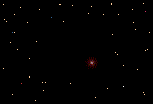
Jupiter is the largest planet of
our solar system, at a distance of 5 A.U. from the Sun and revolves
around it once every 12 years. It alone contains two-thirds of the
mass in the Solar System outside of the Sun, 318 as much as the
Earth. It is 11 times greater in diameter than the Earth and Its
density is estimated to be 1.3 g/cm3.
Jupiter has
many
moons. Observations with a small telescope show four of its moons (Io,
Europa, Ganymede and Calisto, discovered by Galileo in 1610) and reveal
bands of clouds across its surface. Ganymede, at 5,276 km in diameter, is
the largest satellite in the solar system and is larger than the planet
Mercury. Some of Jupiter's moons revolve in the direction opposite from that
of Jupiter's rotation (that is, retrograde), while other moons revolve
prograde.

Jupiter and Io (photo by Cassini
probe)
Jupiter chemical composition is
almost entirely hydrogen and helium and, therefore, is closer to that of the
Sun and stars than it is to that of the Earth. In Jupiter's outer parts,
most of the hydrogen is in the form of hydrogen molecules (H2).Jupiter isn't
solid, it has no crystal surface at all. At deeper and deeper levels, its
gas gets denser and denser, eventually liquefying.
The most prominent feature of the
visible cloud surface of Jupiter is a large reddish oval known as the
Great Red Spot (GRS). It is about 13,000 km x 26,000 km, larger than the
Earth, and drifts about slowly with respect to the clouds as the planet
rotates. The GRS is a relatively stable feature, for it has been
visible for over 350 years. It is an anticyclonic storm, because its
center has high pressure, with counterclockwise winds.
Jupiter rotates very quickly, once
every 10 hours. Its rapid
spin is a major reason for the colorful bands, which are clouds spread out
parallel to the equator. They are in constant turmoil; the shapes and
distribution of bands change in a mater of days. Due to Jupiter's rapid
rotation, the effect that we call the Coriolis force is particularly strong.
Computer models show that under such conditions, large vortices like the
GRS are produced. When many unequal spots are produced, the stronger
ones absorb the weaker ones until only a single vortice is left. Such
vortices last a long time.
Jupiter has bright bands called
"zones" and dark bands called "belts". The zones are rising gas, while the
belts are falling gas. The colors we see in the belts may have to do with
sulfur compounds in the middle clouds, or perhaps with organic molecules.
In what many observers called the
most exciting week ever in astronomy, pieces of periodic Comet
Shoemaker-Levy 9, D/1993 F2, crashed into Jupiter in July 1994.



